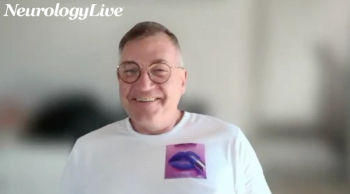
Infantile Spasm-Associated Hypsarrhythmia May Play Role in Autism Risk
Study findings suggest that the presence of hypsarrhythmia—abnormal, chaotic brainwave patterns—may play a role in the risk of autism spectrum disorder in patients with a history of infantile spasms.
Shaun Hussain, MD, MS
New retrospective study data shed some light onto the shared genetic susceptibility associated with infantile spasms, other epilepsy disorders, and autism spectrum disorder (ASD) among siblings.1
While these disorders are known to have some genetic overlap, the full extent of this connection is not well understood. Literature shows that those with infantile spasms have a 30% to 40% risk of developing ASD.2 Some have suggested infantile spasms may be in some way causative of subsequent ASD or epilepsy, but others hypothesize that this risk is linked to genetic predisposition.
The data were presented at the
The study, led by Shaun Hussain, MD, MS, director, Infantile Spasms Program, UCLA Mattel Children’s Hospital, included 294 patients with infantile spasms and ultimately showed that the rates of infantile spasms, ASD, and other epilepsies were relatively low—particularly for ASD, suggesting that the degree of genetic predisposition is limited. As such, it was suggested that hypsarrhythmia—abnormal, chaotic brainwave patterns—may play a role in this risk.
“While about half of the children who had infantile spasms in our study also had ASD, very few of their siblings had any form of epilepsy or ASD,” Hussain said in a statement.3 He noted that the group is optimistic about the potential of therapies that treat infantile spasms—such as corticosteroids, adrenocorticotropic hormone, or vigabatrin—to also treat ASD.
READ MORE:
“We’ve seen several kids with longstanding infantile spasms who seemed severely autistic, but after they were diagnosed and treated, their autistic symptoms—especially impaired social awareness and engagement—dissipated,” Hussain added.
The investigators conducted this retrospective cohort study with a large clinical database that includes all children with video-electroencephalogram confirmed infantile spasms. Using electronic medical records to identify those with a least 1 sibling, the group recorded the putative etiology, genetic testing results, and sibling medical history.
Ultimately, of the 475 patients who were screened, 62% (n = 294) had ≥1 sibling. Among the patients included, 0.3% (n = 1; 95% CI, upper limit 1.9) had a sibling with infantile spasms, 1.7% (n = 5; 95% CI, upper limit 4) had a sibling with another form of epilepsy, and 2% (n = 6; 95% CI, upper limit 4.4) had a sibling with ASD. These rates, Hussain and colleagues noted, are higher than what is seen in the general population but are still low, relatively.
The investigators suggest that the seizures—which can often go unrecognized due to their subtle nature—and abnormal brainwave patterns, may play critical roles in the development of subsequent ASD. Both seizures and abnormal brainwave patterns pose a serious threat to infant brain development.
“This was an exploratory study, and it may be that children with infantile spasms may just have a special type of autism,” Hussain said. “On the other hand, we may have stumbled upon a means to treat or even prevent ASD in general.”
They concluded that the data may provide limited guidance to parents of children with infantile spasms who seek to estimate risk for infantile spasms, as well as that of other epilepsies and ASD in their subsequent children, but the findings warrant replication and arduous further study.
For more coverage of AES 2019,
REFERENCES
1. Sharma V, Hussain S. Risk of infantile spasms, other epilepsy, and autism among siblings of children with infantile spasms. Presented at: AES 2019; December 6—10; Baltimore, Maryland. Abstract 3.234.
2. Saemundsen E, Ludvigsson P, Rafnsson V. Autism spectrum disorders in children with a history of infantile spasms: a population-based study. J Child Neurol. 2007;22(9):1102-7.
3. Chaotic Brainwaves Caused by Infantile Spasms Increase Risk of Autism, Study Suggests Same Medication May Hold Promise in Treating Both Conditions [press release]. Baltimore, MD: American Epilepsy Society; Published December 9, 2019. Accessed December 9, 2019.
Newsletter
Keep your finger on the pulse of neurology—subscribe to NeurologyLive for expert interviews, new data, and breakthrough treatment updates.









































